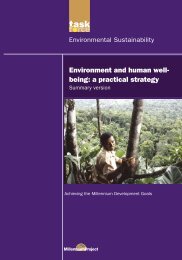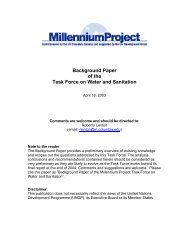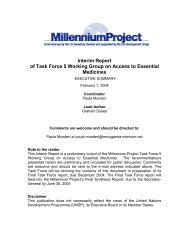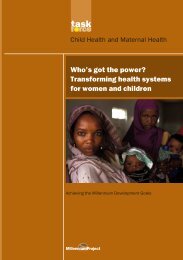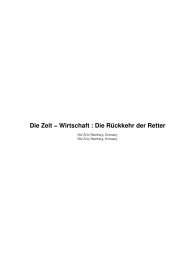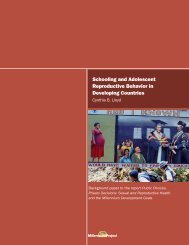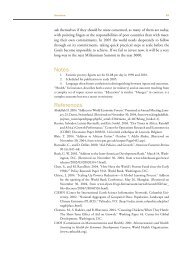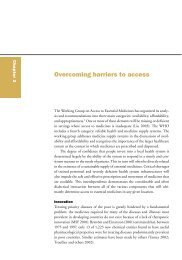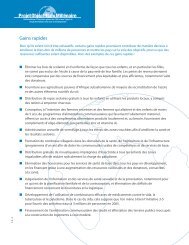the challenges facing landlocked developing countries: a case study ...
the challenges facing landlocked developing countries: a case study ...
the challenges facing landlocked developing countries: a case study ...
Create successful ePaper yourself
Turn your PDF publications into a flip-book with our unique Google optimized e-Paper software.
On <strong>the</strong> positive side, a <strong>landlocked</strong> location can be less burdensome in some circumstances.<br />
Botswana, for instance, exports mainly diamonds, which are shipped by air and thus not<br />
dependent on accessing neighbors’ infrastructure. Ano<strong>the</strong>r example is Swaziland, which is<br />
mostly surrounded by upper middle-income South Africa, a country with good infrastructure,<br />
relatively large internal markets, and large amounts of capital for inward investment. These<br />
<strong>countries</strong> have thus prospered economically despite <strong>the</strong>ir <strong>landlocked</strong>ness.<br />
Aim<br />
While numerous planning papers, legal documents, and transport studies have addressed<br />
issues of transit through neighboring <strong>countries</strong>, near all focus on specific nations or regions,<br />
thus precluding a global cross-country analysis. 3 O<strong>the</strong>r papers focus on distance to port alone<br />
or consider agglomerated economic, social, and financial data for <strong>landlocked</strong> <strong>countries</strong> 4<br />
<strong>the</strong>reby not addressing <strong>the</strong> specific problems of <strong>the</strong> political, transit and social environment.<br />
This report seeks to fur<strong>the</strong>r <strong>the</strong> discussion by presenting a set of 30 <strong>case</strong> studies to distill <strong>the</strong><br />
unique <strong>challenges</strong> each one faces. 5<br />
The <strong>case</strong> studies form <strong>the</strong> core of this paper, and are presented on a region-by-region basis in<br />
Part II. Highlighting <strong>the</strong> main lessons of <strong>the</strong>se <strong>case</strong> studies, <strong>the</strong> remainder of Part I proceeds<br />
in two sections. The first outlines key messages from <strong>the</strong> <strong>case</strong> studies by describing <strong>the</strong><br />
regions most and least affected by infrastructural, political, conflict and administrative issues<br />
in each region. The second <strong>the</strong>n presents some key indicators of development across<br />
<strong>landlocked</strong> <strong>countries</strong>.<br />
A few caveats should be highlighted regarding <strong>the</strong> <strong>case</strong> studies. They do not attempt to<br />
describe <strong>the</strong> general economic or political situations of <strong>the</strong> <strong>countries</strong> studies, unless <strong>the</strong>y are<br />
linked to transit routes. This paper forms a type of reference tool on transit linkages, one to<br />
which <strong>the</strong> reader can refer back when considering <strong>the</strong> details of a country’s economic<br />
situation. Thus <strong>the</strong>re is some repetition between <strong>case</strong> studies, since many of <strong>the</strong> issues that<br />
apply to an individual country also apply to <strong>the</strong> rest of its region. To minimize such<br />
repetition, a short overview of regional issues is included at <strong>the</strong> beginning of each geographic<br />
grouping of <strong>countries</strong>, along with a regional map.<br />
The structure of <strong>the</strong> <strong>case</strong> studies is standardized throughout, but <strong>the</strong> reader will notice that it<br />
varies slightly across <strong>countries</strong> and regions. This is for two main reasons. First, <strong>the</strong> varying<br />
nature of <strong>landlocked</strong>ness in each country requires a different set of emphases in its <strong>case</strong><br />
description. Second, comparable data on <strong>landlocked</strong>ness are not available across most<br />
<strong>countries</strong>. There are no standardized assessments of rail, road or port quality in transit<br />
neighbors, nor of administrative procedures at borders or of transit-related political relations.<br />
This probably speaks to <strong>the</strong> low level of attention often paid to <strong>the</strong> nature of <strong>landlocked</strong>ness<br />
around <strong>the</strong> world. To build a somewhat standardized set of <strong>case</strong> studies, one has to pull<br />
3 As detailed in Glassner (1995).<br />
4 For example, Limao and Venables , MacKellar and Wörgötter (2000), Radelet and Sachs and Stone (2001)<br />
5 The <strong>countries</strong> included in <strong>the</strong> <strong>study</strong> are those with a Human Development Index less than 0.76.<br />
- 5 -






